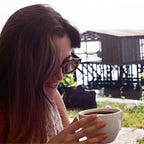Ironhack UX Case Study V
Stress Digest: A wellness app
Brief: Applying the design thinking process to the development of a wellness app for the National Wellness Institute that enables users to adopt & maintain a routine that enhances their wellbeing while targeting 1/6 of the dimensions of health & wellness (as defined by the NWI). The app’s UI must reflect NWI’s refreshed approach to wellness.
Timeline: 9-day sprint
Role: User Research • User Experience Designer • User Interface Designer This was an individual project to which I applied the Double Diamond Design Thinking process to conduct research, insights, and design a UX solution.
The Client
National Wellness Institute: “Providing health promotion & wellness professionals unparalleled resources & services that fuel professional/personal growth”
It was very important to understand the different types of stress to really understand ways to help users. The exercise was stated to be a very effective and natural solution.
Check out my High Fidelity Prototype:
✨case study under construction✨
01. Discover: Insight into the problem
Secondary Research
According to the Mayo Clinic: Exercise in almost any form can act as a stress reliever, boosts physical + mental energy, & enhances well-being…Anything that gets you moving can help…Being active can boost your feel-good endorphins & distract you from daily worries.
I started looking up statistics on how stress __ . I managed to dig up a few interesting facts.. Some of the numbers were striking:
- quote
- quote
Lean UX
With this in mind, I needed to conduct some business analysis using the Lean UX Canvas to make sure I’m establishing a user-centric design process. This helps to define the business, the user, and their desired outcomes.
As a UX designer, I need to make sure I find that sweet spot between the user’s needs, the business goals, and technical feasibility.
Desired business outcomes
User & Customers
User Benefits
Business Analysis
Competitive Feature Chart
Market Positioning Analysis
Once I gathered information in regards to the competitors in the current industry, I used a market positioning map to re-visualize where there is room in the marketplace for a potential future product. This allowed me to pinpoint the value innovation; identifying the ideal “Blue Ocean”.
User Research
Collecting data to understand the Whats, Whys, and Hows
For this project, I sent out a google form survey
Survey: 25 Respondents — Quantitative Data
Interviews: Qualitative Data
Takeaways:
- v
02. Define: Scope down the focus
Affinity Map: Synthesize /Organize Discoveries, Insights, User reactions
Feeling mostly comfortable with the data collection phase, I began to dive deep to see past my initial findings. I scoured the interviews and survey results for consumers’ unmet needs, struggles, frustrations, goals, motivations, and successes, as well as, any pertinent quotes or statistics. I then wrote all these down onto individual Post-It notes and pieced together related topics via affinity mapping techniques.
From the affinity map, three key pains and three key gains floated to the top.
Pains
- Work
- Lack of time
- Lack of motivation
Gains
- Venting
- Gym, Walking, Jogging… → Excercise
Value Proposition
I collected their pains and gains and created a Value Proposition Canvas to understand what jobs this wellness app is able to hold. From my users pains and gains I implemented pain relievers and gain creators to really create an ultimate app for our users.
Jobs to be Done
Based on my results I outlined what is and what isn’t for a job-to-be-done. When focuses on the situation, the wanted focus on the motivation, and the can focus on the outcome. Job stories focus on all four layers of design: outcome, structure, interaction, and visual.
User Persona
Using this information, I defined my persona: Financial-Analyst Andrew.
As an aside, while most of the information is directly derived from the data, some limits present during the research phase inadvertently caused me to make assumptions about Andrew that I would otherwise have resorted to data for. However, from this point forward, all design decisions were a direct result of who Andrew is.
User Journey
I drafted an As-Is Scenario Map to capture the “doing, thinking, feeling” in what a typical day might look like for Andrew.
Strictly guided by Andrew’s day-to-day, I revamped the as-is scenario story into a User Journey Map. This allowed me to really focus on Andrew’s
Problems & Opportunities
Problem Statements:
- Work from home has isolated burnt-out workers — forced to work extremely long hours, they are glued to their desks limiting daily physical movement
- Work-life has absolutely no balance, no time to attend personal wellbeing
- Employees dealing with stress & anxiety are desperate and have no help.
Reframing the problems into solutions:
- How might we help WFH users increase their daily physical activity throughout the workday.
- How might we ensure users prioritize their well-being and engage in stress-relieving activities.
- How might we provide proper guidance and trust in users, and make sure they are being helped.
Takeaways:
- v
03. Develop: Potential Solutions
MoSCoW Method
Minimum Viable Product
A platform that aims to incorporate wellness programs to assist users (employees) by encouraging them to participate in activities that make them move their bodies to pump up their endorphins levels, which will help reduce the negative effects of stress and prevent the risk factors of staying stationary for prolonged periods.
User Flow
Site Map
04. Deliver: Solutions that work & Receive feedback
Visual Competitive Analysis
Low-Fidelity Prototype
Mid-Fidelity Prototype
High-Prototype Prototype
Success & Failure Metrics
- UX Solutions: that sweet spot that works in the best interest of both the business and user goals in a technically feasible way.
Next Steps
- Test high-fidelity prototype
- Figure out the logistics of the business and rewards program implementation
Key Takeaways & Learnings
- logistics of the business and rewards program implementation
